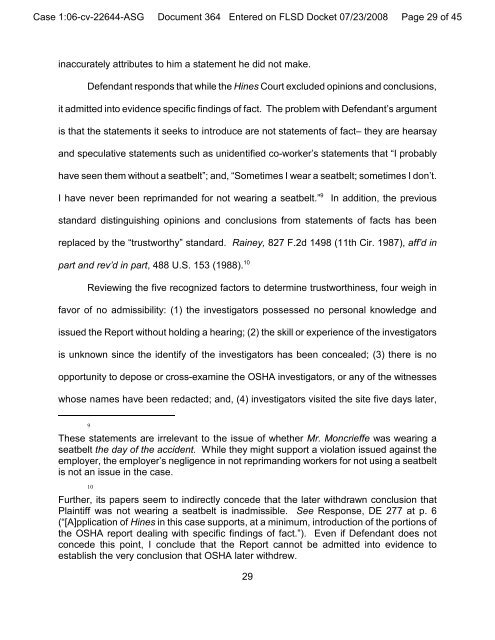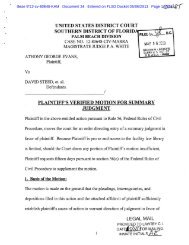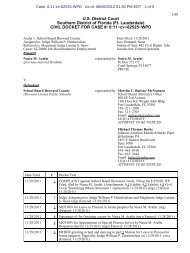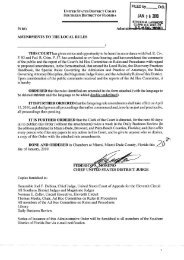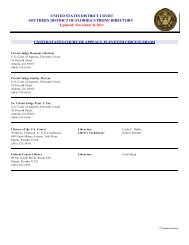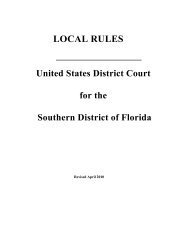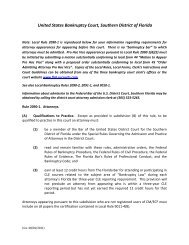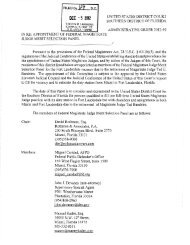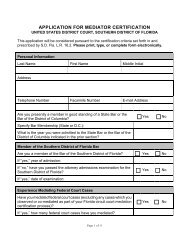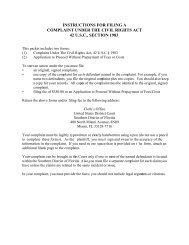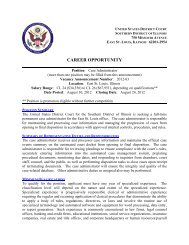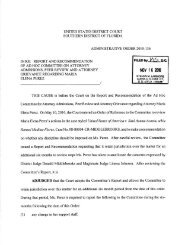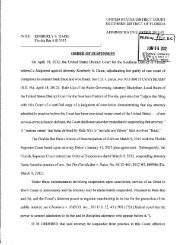Motion in Limine - United States District Court
Motion in Limine - United States District Court
Motion in Limine - United States District Court
You also want an ePaper? Increase the reach of your titles
YUMPU automatically turns print PDFs into web optimized ePapers that Google loves.
Case 1:06-cv-22644-ASG Document 364 Entered on FLSD Docket 07/23/2008 Page 29 of 45<br />
<strong>in</strong>accurately attributes to him a statement he did not make.<br />
Defendant responds that while the H<strong>in</strong>es <strong>Court</strong> excluded op<strong>in</strong>ions and conclusions,<br />
it admitted <strong>in</strong>to evidence specific f<strong>in</strong>d<strong>in</strong>gs of fact. The problem with Defendant’s argument<br />
is that the statements it seeks to <strong>in</strong>troduce are not statements of fact– they are hearsay<br />
and speculative statements such as unidentified co-worker’s statements that “I probably<br />
have seen them without a seatbelt”; and, “Sometimes I wear a seatbelt; sometimes I don’t.<br />
9<br />
I have never been reprimanded for not wear<strong>in</strong>g a seatbelt.” In addition, the previous<br />
standard dist<strong>in</strong>guish<strong>in</strong>g op<strong>in</strong>ions and conclusions from statements of facts has been<br />
replaced by the “trustworthy” standard. Ra<strong>in</strong>ey, 827 F.2d 1498 (11th Cir. 1987), aff’d <strong>in</strong><br />
10<br />
part and rev’d <strong>in</strong> part, 488 U.S. 153 (1988).<br />
Review<strong>in</strong>g the five recognized factors to determ<strong>in</strong>e trustworth<strong>in</strong>ess, four weigh <strong>in</strong><br />
favor of no admissibility: (1) the <strong>in</strong>vestigators possessed no personal knowledge and<br />
issued the Report without hold<strong>in</strong>g a hear<strong>in</strong>g; (2) the skill or experience of the <strong>in</strong>vestigators<br />
is unknown s<strong>in</strong>ce the identify of the <strong>in</strong>vestigators has been concealed; (3) there is no<br />
opportunity to depose or cross-exam<strong>in</strong>e the OSHA <strong>in</strong>vestigators, or any of the witnesses<br />
whose names have been redacted; and, (4) <strong>in</strong>vestigators visited the site five days later,<br />
9<br />
These statements are irrelevant to the issue of whether Mr. Moncrieffe was wear<strong>in</strong>g a<br />
seatbelt the day of the accident. While they might support a violation issued aga<strong>in</strong>st the<br />
employer, the employer’s negligence <strong>in</strong> not reprimand<strong>in</strong>g workers for not us<strong>in</strong>g a seatbelt<br />
is not an issue <strong>in</strong> the case.<br />
10<br />
Further, its papers seem to <strong>in</strong>directly concede that the later withdrawn conclusion that<br />
Pla<strong>in</strong>tiff was not wear<strong>in</strong>g a seatbelt is <strong>in</strong>admissible. See Response, DE 277 at p. 6<br />
(“[A]pplication of H<strong>in</strong>es <strong>in</strong> this case supports, at a m<strong>in</strong>imum, <strong>in</strong>troduction of the portions of<br />
the OSHA report deal<strong>in</strong>g with specific f<strong>in</strong>d<strong>in</strong>gs of fact.”). Even if Defendant does not<br />
concede this po<strong>in</strong>t, I conclude that the Report cannot be admitted <strong>in</strong>to evidence to<br />
establish the very conclusion that OSHA later withdrew.<br />
29


